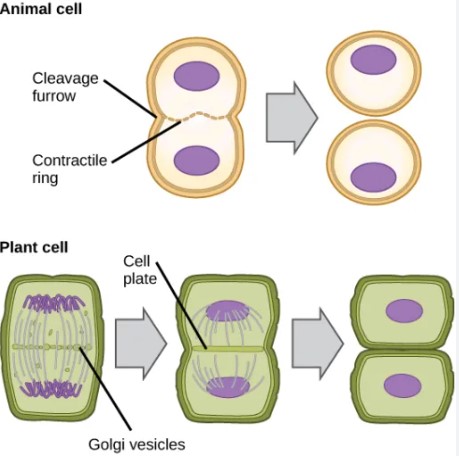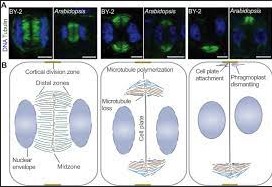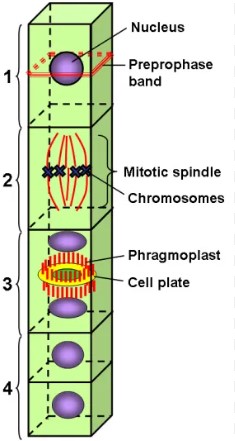The intricate dance of cellular division is a marvel of biology, especially within the realm of plant cells. Two key players in this process, the phragmoplast and cell plate, ensure the seamless partitioning of a mother cell into daughter cells. Their roles, while distinct, are pivotal in the life cycle of plants, facilitating not just growth but also regeneration and reproduction.
The phragmoplast serves as a framework for assembling the cell plate, the precursor to a new cell wall that separates dividing cells. Essentially, the phragmoplast is a complex of microtubules and proteins that forms between the daughter nuclei, while the cell plate is the structure that develops at the midpoint of the dividing cell, ultimately fusing with the cell’s sides to partition it into two.
Understanding the functions and differences of the phragmoplast and cell plate is crucial in cell biology. These structures not only highlight the complexity of plant cell division but also underline the unique mechanisms plants have evolved to grow and thrive. By examining their roles, we gain insights into the fundamental processes that underpin plant development and the potential applications in biotechnology and agriculture.

Cell Division Basics
Cell division is a fundamental process that occurs in all living organisms. It is the method by which a single cell divides into two or more daughter cells, enabling growth, reproduction, and, in some cases, repair and regeneration of tissues. This complex and tightly regulated process is crucial for the life cycle of both unicellular and multicellular organisms.
Types of Cell Division
There are two main types of cell division: mitosis and meiosis. While both are essential for life, they serve different purposes and occur in different contexts within an organism.
Mitosis and Cytokinesis Overview
Mitosis is the process of nuclear division that ensures each daughter cell receives an identical set of chromosomes. It is followed by cytokinesis, the division of the cell’s cytoplasm, which physically separates the cell into two daughter cells. Mitosis is vital for growth, tissue repair, and asexual reproduction in multicellular organisms, as well as reproduction in some unicellular organisms.
The stages of mitosis include:
- Prophase: Chromosomes condense and become visible. The nuclear envelope breaks down.
- Metaphase: Chromosomes align at the cell’s equator.
- Anaphase: Sister chromatids separate and move to opposite poles of the cell.
- Telophase: Nuclear envelopes reform around the separated chromosomes.
Following mitosis, cytokinesis completes the cell division process, resulting in two genetically identical daughter cells.
Role in Growth and Development
Cell division is critical for the growth and development of organisms. In multicellular organisms, mitosis facilitates growth by increasing the number of cells. It also replaces worn-out or damaged cells, ensuring tissue integrity and health. In unicellular organisms, cell division is the means of reproduction, leading to an increase in population size.
Plant Cell Division
Plant cell division is unique in several ways, primarily due to the presence of a rigid cell wall that requires a specialized mechanism for cytokinesis.
Unique Features
Unlike animal cells, plant cells undergo cytokinesis through the formation of a cell plate, a process guided by the phragmoplast. The presence of a cell wall necessitates a different approach to physically separate the cytoplasm and form two daughter cells.
Significance of Phragmoplast and Cell Plate
The phragmoplast and cell plate are integral to plant cell division, ensuring that each daughter cell receives a portion of the cytoplasm and a complete set of chromosomes, as well as initiating the formation of a new cell wall between them. This unique mechanism highlights the adaptability and diversity of cellular processes across different life forms.
Phragmoplast Overview
The phragmoplast is a plant-specific structure that plays a critical role in cell division, particularly in the formation of the cell plate.
Definition and Structure
Basic Description
The phragmoplast is an array of microtubules, actin filaments, and other proteins that forms perpendicular to the axis of division in a cell. It serves as a scaffold for the assembly of the cell plate, guiding its formation and ensuring accurate division of the cell into two.
Composition and Formation
The phragmoplast originates from the remains of the mitotic spindle, the structure that separates chromosomes during mitosis. It is composed of:
- Microtubules: Provide structural support.
- Actin filaments: Aid in vesicle movement.
- Golgi-derived vesicles: Supply the materials necessary for cell plate formation.
Function
Role in Cell Division
The primary role of the phragmoplast is to facilitate the formation of the cell plate, which will become the new cell wall separating the daughter cells. It does so by:
- Directing vesicles to the center of the cell.
- Ensuring the delivery of cell wall precursors.
Interaction with Other Cellular Components
The phragmoplast interacts closely with the Golgi apparatus, which produces the vesicles required for cell plate formation. It also coordinates with the existing cell wall and plasma membrane to integrate the newly formed cell plate seamlessly.
Cell Plate Overview
The cell plate is a critical structure in plant cell cytokinesis, serving as the foundation for the new cell wall that divides the mother cell.
Definition and Formation
Description of Cell Plate
The cell plate is the precursor to the new cell wall that forms between dividing plant cells. It is composed of vesicles that fuse together at the center of the cell, gradually expanding outward until it reaches the existing cell walls, effectively dividing the cell into two.
Process of Formation
The formation of the cell plate is a multi-step process:
- Vesicles from the Golgi apparatus converge at the center of the cell.
- Fusion of these vesicles forms the initial cell plate.
- The cell plate expands laterally, guided by the phragmoplast, until it merges with the cell wall.
Function
Importance in Cytokinesis
The cell plate is essential for cytokinesis in plant cells, providing a mechanism to divide the cell’s contents evenly between the daughter cells. Without the cell plate, plants would not be able to successfully complete cell division, affecting growth and development.
Integration into the Cell Wall
Once formed, the cell plate integrates with the existing cell walls to become a new section of the cell wall, separating the daughter cells. This process not only divides the cell but also ensures that each daughter cell is enclosed within a fully functional cell wall, maintaining the structural integrity and viability of the cells.

Comparing Phragmoplast and Cell Plate
Understanding the intricacies of plant cell division necessitates a closer look at two pivotal structures: the phragmoplast and the cell plate. These elements play crucial roles in ensuring the cell divides accurately and efficiently, but they do so in ways that are distinct yet interconnected.
Structural Differences
Physical Characteristics
The phragmoplast is characterized by its dynamic assembly of microtubules, actin filaments, and motor proteins, forming a complex structure that guides the cell plate’s formation. It is essentially a cellular scaffold that emerges in the late stages of cell division, specifically during telophase, and expands outward from the center of the cell.
In contrast, the cell plate is a membrane-bound structure that materializes at the site of division, marking the future wall between daughter cells. It is primarily composed of cellulose and other cell wall materials, delivered to the center of the cell by vesicles that fuse to form the initial plate.
Composition Comparison
- Phragmoplast: Comprises mainly of protein structures like microtubules and actin, alongside various enzymes that facilitate vesicle movement and fusion.
- Cell Plate: Consists of lipids, proteins, and carbohydrates that are precursors to the cell wall, including cellulose.
Functional Differences
Roles in Cell Division
The phragmoplast functions as a guide for the assembly and expansion of the cell plate. It ensures that division occurs precisely, with each daughter cell receiving equal and accurate portions of the cell’s contents. Its role is primarily organizational and structural, directing the vesicles that form the cell plate to their correct location.
The cell plate, however, is the physical manifestation of the new cell wall. It begins as a series of vesicles that coalesce in the center of the cell, expanding outward under the guidance of the phragmoplast until it integrates with the cell’s existing walls, thus completing the division process.
Timing and Sequence in Cytokinesis
- Phragmoplast Formation: Initiates during the late stages of mitosis, following chromosome separation.
- Cell Plate Formation: Begins with the phragmoplast’s guidance, culminating in the complete separation of the daughter cells.
This sequence underscores the dependency of the cell plate’s formation on the phragmoplast, illustrating a tightly coordinated process that ensures successful cell division.
Evolutionary Perspectives
Origin and Evolution
The evolution of the phragmoplast and cell plate mechanisms highlights a significant divergence in the cellular division processes between plant and animal kingdoms. The phragmoplast and cell plate are believed to have evolved to manage the challenges posed by the rigid cell walls of plants, facilitating efficient cytokinesis in a way that is unique to plant cells.
Significance in Plant Evolution
This evolutionary adaptation has been pivotal in allowing plants to thrive in a wide range of environments. The efficiency of cell division, ensured by the phragmoplast and cell plate, supports robust growth, regeneration, and adaptation capabilities in plants, contributing significantly to the diversity and resilience of plant life on Earth.
Impact on Plant Growth
Role in Growth and Development
The precise division of plant cells, facilitated by the phragmoplast and cell plate, is critical for plant growth and development. It ensures that each new cell receives the appropriate genetic material and cellular organelles, contributing to the healthy growth of tissues and the plant as a whole.
Influence on Plant Structure
The mechanisms of phragmoplast and cell plate formation are directly linked to the development of plant structure. They enable plants to grow taller and stronger, forming the complex tissues needed for various functions, such as photosynthesis and nutrient transport, which are essential for survival and reproduction.
Implications for Agricultural Science
Understanding the role of the phragmoplast and cell plate in plant cell division has profound implications for agricultural science. It opens up possibilities for enhancing crop yields, improving disease resistance, and developing plants better suited to withstand environmental stresses.
Genetic Manipulation
Advances in Genetic Engineering
Recent advances in genetic engineering have enabled scientists to manipulate the genes responsible for the formation and function of the phragmoplast and cell plate. These manipulations can lead to plants that grow more efficiently, use water and nutrients more effectively, and are more resistant to pathogens.
Potential for Crop Improvement
The potential for crop improvement through genetic manipulation of cell division processes is vast. By understanding and altering the genes that control the phragmoplast and cell plate, scientists can create crops that are more productive, sustainable, and resilient, offering solutions to some of the most pressing challenges in global food security.

Frequently Asked Questions
What is a Phragmoplast?
The phragmoplast is a cell structure that forms during the late stages of cell division in plants. It acts as a scaffold for the cell plate, guiding it to the correct location between the dividing nuclei. Comprised of microtubules, actin filaments, and various proteins, it’s essential for the successful cytokinesis in plant cells.
How does the Cell Plate Form?
Cell plate formation begins with the accumulation of vesicles in the center of the cell. These vesicles, derived from the Golgi apparatus, fuse to create a disc-like structure that expands outward toward the cell walls. This process is orchestrated by the phragmoplast, ensuring the cell plate integrates properly to form a new cell wall, dividing the cell into two distinct daughter cells.
Why are Phragmoplast and Cell Plate Important?
The phragmoplast and cell plate are fundamental to plant cell cytokinesis, ensuring cells divide properly during growth and reproduction. Their precise function and coordination are crucial for maintaining the integrity of the cell wall and the overall health of the plant. Disruptions in their function can lead to defective cell division, affecting plant development and growth.
Can Animals Form Phragmoplast and Cell Plate?
No, animals do not form a phragmoplast or a cell plate during cell division. These structures are unique to plant cells. Animal cells utilize a different mechanism, known as a cleavage furrow, to achieve cytokinesis. This highlights the distinct evolutionary pathways plants and animals have taken in developing mechanisms for cell division.
Conclusion
The phragmoplast and cell plate are not just cellular components; they are the architects of plant growth and development. Their roles in guiding the successful division of plant cells underscore a complex, yet beautifully orchestrated process that is fundamental to life. As we continue to explore the cellular mechanics of plants, the insights gained not only deepen our understanding of biology but also open avenues for enhancing agricultural productivity and sustainability.
In reflecting on the intricacies of plant cell division, it’s clear that the dance between the phragmoplast and cell plate is a testament to the elegance of nature’s design. These structures remind us of the ongoing quest for knowledge in the biological sciences, a journey that continually reveals the sophisticated mechanisms underlying life itself.

